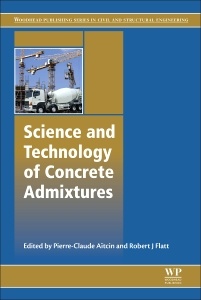Science and Technology of Concrete Admixtures
Coordonnateurs : Aïtcin Pierre-Claude, Flatt Robert J

Science and Technology of Concrete Admixtures presents admixtures from both a theoretical and practical point-of-view. The authors emphasize key concepts that can be used to better understand the working mechanisms of these products by presenting a concise overview on the fundamental behavior of Portland cement and hydraulic binders as well as their chemical admixtures, also discussing recent effects in concrete in terms of rheology, mechanics, durability, and sustainability, but never forgetting the fundamental role played by the water/binder ratio and proper curing in concrete technology.
Part One presents basic knowledge on Portland cement and concrete, while Part Two deals with the chemical and physical background needed to better understand what admixtures are chemically, and through which mechanism they modify the properties of the fresh and hardened concrete. Subsequent sections present discussions on admixtures technology and two particular types of concrete, self-consolidating and ultra-high strength concretes, with final remarks on their future.
Preface
Table of content
Introduction
Terminology and definitions
Glossary
Historical background of the development of concrete admixtures
Part 1: Theoretical background on Portland cement and concrete
Chapter 1 Water-cement and water-binder ratios
Chapter 2 Phenomenology of cement hydration
Chapter 3 Portland cement
Chapter 4 Supplementary cementitious materials and fillers
Chapter 5 Water
Chapter 6 Entrained air
Chapter 7 Concrete rheology
Chapter 8 Mechanisms of cement hydration
Part 2: Chemistry and working mechanisms
Chapter 9 Chemistry of chemical admixtures
Chapter 10 Adsorption of chemical admixtures
Chapter 11 Working mechanisms of water reducers and superplasticizers
Chapter 12 Impact of chemical admixtures on cement hydration
Chapter 13 Working mechanisms of Shrinkage Reducing Admixtures
Chapter 14 Working Mechanisms of Corrosion of Reinforcing Steel
Part 3: The technology of admixtures
Chapter 15 Formulation of chemical admixtures
Chapter 16 Superplasticizers in practice
Chapter 17 Air entraining agents
Chapter 18 Retarders
Chapter 19 Accelerators
Chapter 20 Viscosity modifiers
Chapter 21 Antifreezing admixtures
Chapter 22 Expansive admixtures
Chapter 23 Shrinkage modifiers
Chapter 24 Corrosion inhibition
Chapter 25 Curing membranes and evaporation retarders
Parts 4 and 5: Special concretes and the Future of Admixtures
Chapter 26 Self-consolidating concrete
Chapter 27 Ultra-high strength concrete
Chapter 28 Conclusion and outlook
Appendices
- High Performance concrete published by E and FN SPON. This book has been translated in French, Spanish, Portuguese and Czech.
-
- Binders for Durable and Sustainable Concrete published by Taylor and Francis.
-
- In collaboration with Sidney Mindess he wrote Sustainability of Concrete published by Taylor and Francis. This book has been published in French by Eyrolles under the title Ecostructures en béton- Comment diminuer l’empreinte carbone des structures en béton.
Robert J. Flatt is Professor of Building Materials at ETHZ. Before that he was Principal Scientist at Sika Technology AG and postdoctoral researcher at the Princeton University. He owns a master in Chemical Engineering and a PhD from EPFL. His main research interest deals with the working mechanisms of chemical admixtures, an area in which his publications are very well cited and in which he has received several awards. These include the RILEM Robert L’Hermite Medal, the Ross C. Purdy and the Brunauer awards from the American Ceramic Society, the best short presentation at the 13th International Conference on Cement Chemistry, as well an Outstanding Research Contribution in the Broad Area of Chemical Admixtures presented at the 10th International Conference on Superplasticizers and Other Chemical Admixtures.
He was also nominated two years in a row among the 5 finalists for the Spark award recognizing the best invention of the year at ETH Zürich (each time among more than 100 filed patents covering all subjects). He also was awarded the best paper award in two of the four categories at the 1st International conference on concrete innovation in 2014.
- Combines the knowledge of two leading authors to present both the scientific and technology of admixtures
- Explains what admixtures are from a chemical point-of-view and illustrates by which mechanisms they modify the properties of fresh and hardened concrete
- Presents a fundamental, practical, and innovative reference book on the topic
- Contains three detailed appendices that can be used to learn how to use admixtures more efficiently
Date de parution : 11-2015
Ouvrage de 666 p.
15x22.8 cm



